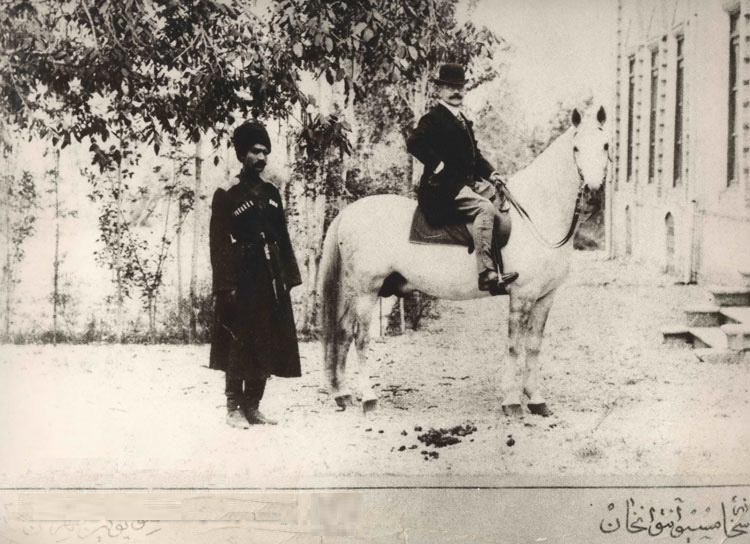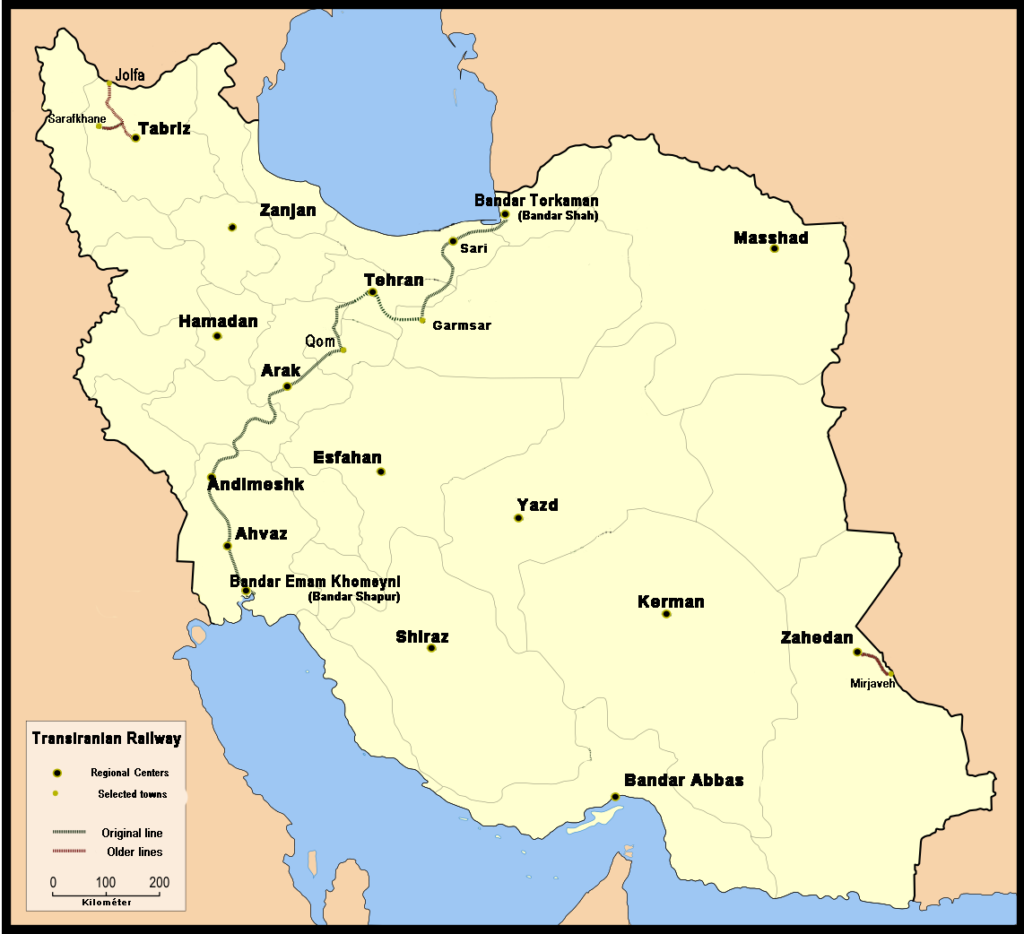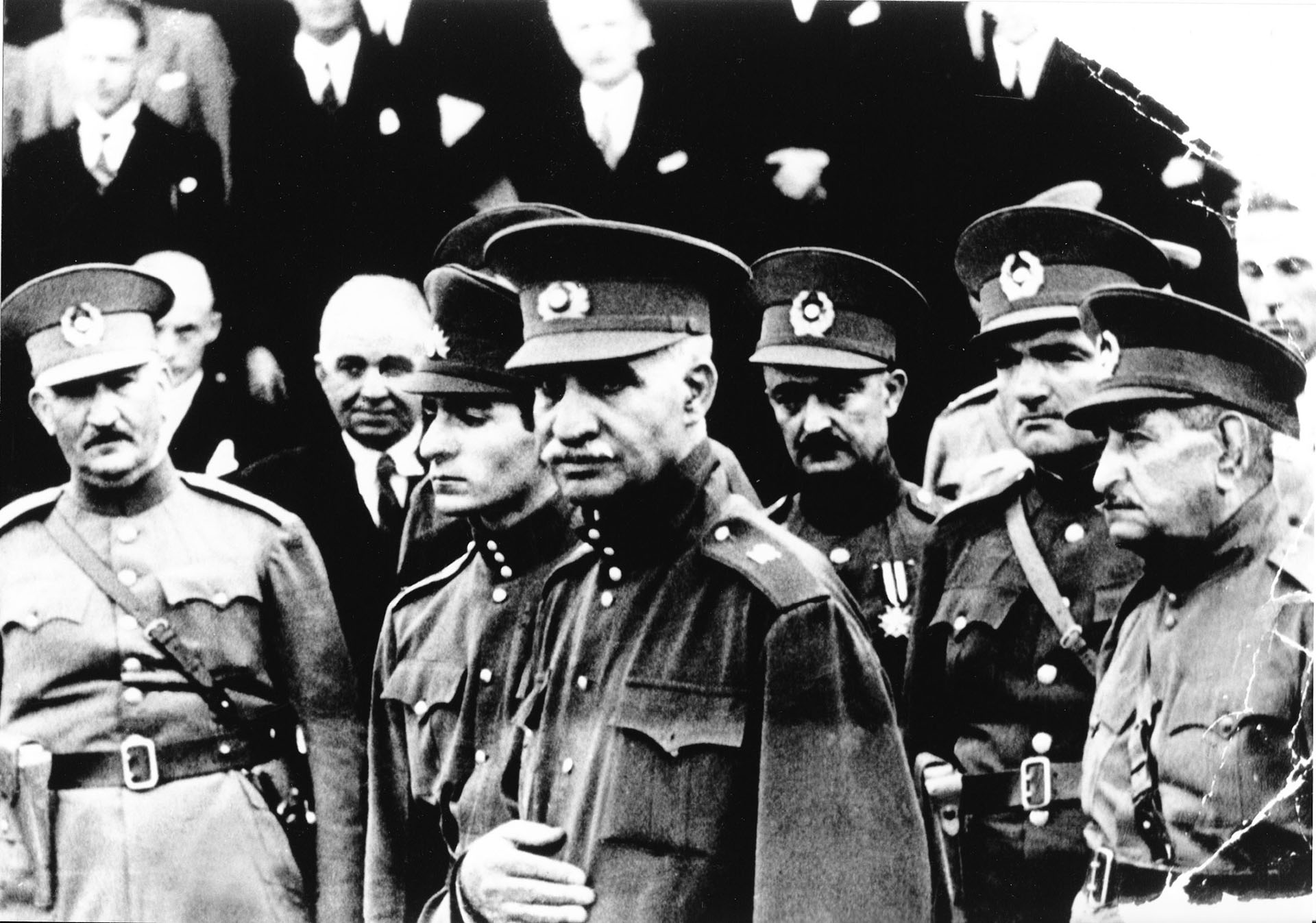Today, Iran is ruled by a theocratic regime. It is easy to blame the mullahs for all of Iran’s ills. However, it is an inconvenient truth that their path to power was paved by the British and the Americans.
In the recent protests, unknown assailants have attacked banks, police, ambulances, other government officials, mosques, clerics and religious people. During their attacks, protesters often yell, “Reza Shah ruhat shad,” a phrase that literally translates to “Reza Shah, may your soul be happy.” These protesters are totally ignorant about the fact that, if Reza Shah was in power, he would have all of them killed. History tells us that Reza Shah dealt brutally with his opponents and crushed any sign of dissent.
British Domination and Exploitation
The British began interfering in Iran as early as the late 18th century. At that time, Persia, as Iran was then called, was under pressure from the Ottomans and the Russians. To Persians, the British seemed a countervailing power. To Britain, Persia was like Egypt, a buffer state to protect the jewel in the crown: India. The British did not rule Iran directly but dominated the country through bribery and intimidation. A cadre of collaborators helped the British Empire to run Persia as an informal colony. The British drained the Persian bullion to support their Indian ventures. Unlike Egypt though, Persia never became a protectorate thanks to the resistance of Shia religious leaders.
Why are Young People Protesting in Iran?
Persia became increasingly important to British interests in the early 20th century. While Egypt had the Suez Canal, Persia had oil. In 1914, before World War I broke out, the House of Commons backed Winston Churchill’s proposal for the British government to acquire 51% of the shares of Anglo-Persian. Churchill was determined to keep Anglo-Persian an absolutely “all British Company” and spent a then princely sum of £2.2 million to do so. The goal was to ensure energy security for Great Britain where the Royal Navy switched from coal to oil to compete against the fast-rising German navy.
After World War I broke out, Persia remained neutral but supplied oil to Britain. In fact, Persian oil arguably led to Allied victory. The “conversion of the British fleet to oil… [gave them] advantages over the German fleet powered by coal–greater range and speed and faster refueling.” In keeping with their imperial tradition, Britain paid a pittance to Persia for oil.
Britain not only exploited Persia for oil but also grain. This led to the 1917-18 famine. About nine million Persians died, an estimated 40% of the population. Scholars have called this a genocide and, arguably, it was the biggest tragedy of World War I, exceeding the loss of life in Somme and Verdun. The British skilfully blamed the Russians and the Turks, and the genocide remained unknown for nearly a century.
The British Enthrone Ruthless Reza Mirpanj
After the Russian Revolution of 1917, Persia became a frontline state for the British Empire to counter the Bolshevik menace. As in other countries, the Soviets tried to foment trouble in Persia. Britain countered by propping up Reza Mirpanj, an officer in the Persian Cossack Brigade. He went on to depose the Qajar dynasty in 1925 and declare himself shah. The rubber stamp parliament approved Reza Mirpanj’s power grab.
Once he became shah, this opportunistic officer changed his name to Reza Shah Pahlavi. Importantly, the Persian language was called Pahlavi during the Sasanian Empire. The Sasanian dynasty centralized Persia and made it a great power. Choosing Pahlavi was a very clever public relations stunt. Not everyone bought into Reza Shah’s sham. Four courageous legislators opposed the new shah. One of them was Mohammad Mosaddegh who would go on to become prime minister years later. The British managed Reza Shah’s coronation using the coronation of George V as their guide.

Reza Shah presided over the greatest loot of Iranian historical and cultural relics. In 1931, he allowed foreign archaeologists to explore Iran and excavate Persepolis, the capital of the ancient Persian Achaemenid empire founded by Darius the Great in the 6th century BCE. His regime looked the other way as they loaded invaluable ancient artifacts onto big trucks. Then these trucks made their way from Persepolis to the Persian Gulf. Eventually, these artifacts ended up in the US and other prosperous countries of the West. Many relics ended up at the University of Chicago where they are housed in the appositely colonial sounding Oriental Institute.
The new shah turned out to be a classic British lackey. He stamped out Soviet influence and built the Trans-Iranian Railway connecting the Caspian Sea to the Persian Gulf. Built at ruinous cost to the Iranian taxpayer, this allowed British troops to deploy faster to counter the Soviets. Most importantly, the shah increased oil concessions to the British. The British increased their oil production in Persia from around 5 million tons (37 million barrels, equivalent) in 1932 to 10 million tons (over 74 million barrels, equivalent) in 1938. Note that very little of this old money trickled down to the Persian treasury and oil revenue comprised merely 10% of the budget.

In 1936, protests against Reza Shah’s policies erupted in Mashhad. The security forces cracked down the protesters. The protesters sought sanctuary in the holiest place in Iran: Imam Reza’s mausoleum. On the shah’s order, security forces entered the mausoleum and viciously massacred people. After that slaughter, Reza Shah became damned to eternity to most Iranians. After that incident, many people feared to even say his name, but referred to him as sag, which means dog—considered the most derogative of abuses in the Farsi language.
For increasing military might and expensive projects, Reza Shah had to increase the tax burden on the people. He also pursued a policy of centralization and Persianization. This meant ethnic minorities had no place in Persia, which he named Iran — the name used by natives of the land. Reza Shah’s detribalization and Persianization led to ethnic cleansing and genocide. William Douglas, a noted American judge, had the following to note about one community that fell foul of Reza Shah:
“Lur after Lur was beheaded. Again and again, the plate was heated red hot and slapped on the stub of a neck….The colonel started betting on how far these headless men could run…. Every man, woman, and child had been killed. Not a living soul was left.”
Overall, Reza Shah was a disaster for Iran. He banned all newspapers, organizations, and any opposition. Intellectual and political expression was censored. This undid the remnant of reformist efforts kicked off by Amir Kabir, the remarkable modernizer of the mid-19th century. who preceded him about 80 years earlier. This reformer had started Vaqaye Etefaqieh, Iran’s first newspaper whose name literally translates as “The Happened Events.”
The Iran Nuclear Deal is Dead: R.I.P. JCPOA?
İnspired by Mustafa Kemal Atatürk of Turkey, Reza Shah banned Iranian traditional dress. Both men and women now had to wear Western clothing. If they did not do so, they were beaten and even taken into custody. This policy caused a massive rupture with tradition. In small towns and villages, people ignored the shah’s edict. In cities, people suffered, especially the women. Many women stopped going to public places to avoid harassment and became involuntary prisoners within their own homes. Like many other policies, the shah’s policy on clothing was an unmitigated disaster. It led to resentment across the country and had unintended consequences. Today, the mullahs enforce rigid rules of dress on women in much the same way as the shah. Then too, women protested as they are protesting today.
Bloodthirsty at Home, Weak Abroad
Reza Shah might have been ruthless to ethnic minorities and desenters but he was always subservient to the great powers. He gave away many parts of Iran to buy peace. Scared of the Soviets, he gifted them the Firoze region, which lies today in Turkmenistan and is home to its capital Ashgabat, in 1933. Later, Reza Shah succumbed to British pressure and parted with more land. In 1937, the wily Brits convened a meeting to unite Muslims against the Bolsheviks. The Saadabad Treaty was signed. As per this treaty, Reza Shah gave the Helmand wetland to Afghanistan, full rights of Shatt al-Arab to Iraq and the strategic Ararat Mountain to Turkey. This Iranian that Reza Shah gave to Turkey allows Turkish troops access to the Nakhchivan Autonomous Republic of Azerbaijan, which is an enclave of Azerbaijan within Armenia. Consequently, Turkey has replaced Iran as the natural ally of Azerbaijan even though the country is 85% Shia and Azeri culture has been deeply influenced by its Iranian counterpart.
Han and Hindu Nationalism Come Face to Face
In World War II, Reza Shah overplayed his hand. The rise of Nazi Germany swayed his head. By engaging with the Nazis, he began playing a dangerous game. Once the Germans invaded Russia in 1941, the British and the Soviets invaded Iran to secure oil supplies and continued access to warm waters. Reza Shah’s troops capitulated. The reason was simple. Reza Shah had started as a cavalry gendarme. These gendarmes were backed by landlords and their main job was to keep the peasants in check. They were bullies who lived off the fat of the land and not patriots who were serving to fight for their country. When the British and the Soviets invaded, most of Reza Shah’s top officers simply fled. Reza Shah himself proved to be a coward who did not resist the invading powers in the slightest. The military historian Robert Lyman observed that the British victory was, “one of the fastest capitulations in history.”
Part of the reason Reza Shah lost was because he was a corrupt, cruel and incompetent autocrat. He was a lowly cavalry officer who was part of a coup and then conducted a coronation. Once on the throne, this autocrat engaged in a massive land grab across the country. By the time the British packed him off to exile in 1941, Reza Shah had become Iran’s largest landowner. He also deposited a fair bit of cash at British Barclays Bank. The money that should have been used to build roads, schools and hospitals became the private property of a bloodthirsty upstart.
Fundamentally, Reza Shah was a narcissist, not a patriot. When the British took over Iran, he was more worried about preserving his private wealth instead of fighting for his country. By this time, this king had lost the trust of his people. The canny British had been keeping an eye on him. About 15 years ago, the imperial diplomat Harold Nicholson observed, “He [Reza] is secretive, suspicious, and ignorant; he appears wholly unable to grasp the realities of the situation or to realize the force of the hostility he has aroused.” Nicholson proved prophetic.
The Modern Reza Shah Myth is a Lie
When Reza Shah and his son Mohammad Reza Shah ruled, writers and teachers lied to survive. Flattery was the order of the day. Reza Shah was glorified as a “social, economic, and political” reformer who laid the foundation for modern Iran. He was even given credit for reforms instituted by Amir Kabir. The regime kept Iranians in the dark about Reza Shah’s paranoid, violent and oppressive rule. Iranians did not realize how this corrupt king betrayed Iran to the British and stole from the exchequer.
Apologists for the Pahlavis claim that Reza Shah brought modern medicine to Iran. The truth is that the Pasteur Institute of Iran had begun in 1919, many years before he seized power. It was the first public health institution in the Middle East, producing vaccines for the region. Hospitals existed even in ancient Iran. Reza Shah was not the first to build hospitals in the country. To be fair, he did build a few but so did almost every colony from Nigeria to Vietnam.
The most incongruous myth pervasive in the Iranian diaspora is that Reza Shah ended capitulation and expelled foreign forces from Iran. History tells us that Iranians had always opposed foreign troops. Amir Kabir had called for their expulsion 80 years ago. The British saw the writing on the wall, withdrew their troops but exercised power behind the scenes. British troops did not march down streets in Tehran in contrast to New Delhi. Instead the British used Reza Shah to do their dirty work in Iran.
Some give credit for railways, roads, industries and instituting a civil registry in Iran. The railways were for British strategic interest and cost the Iranian taxpayer a fortune. The roads were few and terrible. Industries came because Iranians have traded for centuries. Entrepreneurs learnt from Europeans and set up factories. Besides, Iranians had been producing sugar and textiles, two industries showcased by his supporters, for centuries. The registry was demanded by the parliament five years before Reza became shah.
Reza Shah’s regime failed to serve Iran. At the moment of reckoning, he and his troops just ran away. He was a thug in uniform who looted the country and killed innocents. He served imperial powers, not his people. Ayatollah Khomeini was not wrong when he said, “The Pahlavi monarchy was against the law from the day it was established. They formed a fake Constituent Assembly and forcefully made him [Reza Khan] the ruler over Iran. ”Today, protesters in Iran chanting “Reza Shah ruhat shad” need to study their history. Iran needs freedom, democracy and equality, not the glamorization of a paranoiac, cowardly, murderous, and traitorous shah.
The views expressed in this article are the author’s own and do not necessarily reflect Fair Observer’s editorial policy.
Support Fair Observer
We rely on your support for our independence, diversity and quality.
For more than 10 years, Fair Observer has been free, fair and independent. No billionaire owns us, no advertisers control us. We are a reader-supported nonprofit. Unlike many other publications, we keep our content free for readers regardless of where they live or whether they can afford to pay. We have no paywalls and no ads.
In the post-truth era of fake news, echo chambers and filter bubbles, we publish a plurality of perspectives from around the world. Anyone can publish with us, but everyone goes through a rigorous editorial process. So, you get fact-checked, well-reasoned content instead of noise.
We publish 2,500+ voices from 90+ countries. We also conduct education and training programs
on subjects ranging from digital media and journalism to writing and critical thinking. This
doesn’t come cheap. Servers, editors, trainers and web developers cost
money.
Please consider supporting us on a regular basis as a recurring donor or a
sustaining member.
Will you support FO’s journalism?
We rely on your support for our independence, diversity and quality.







Comment